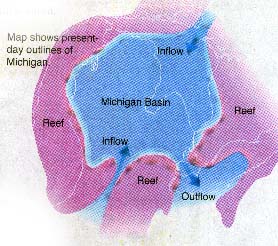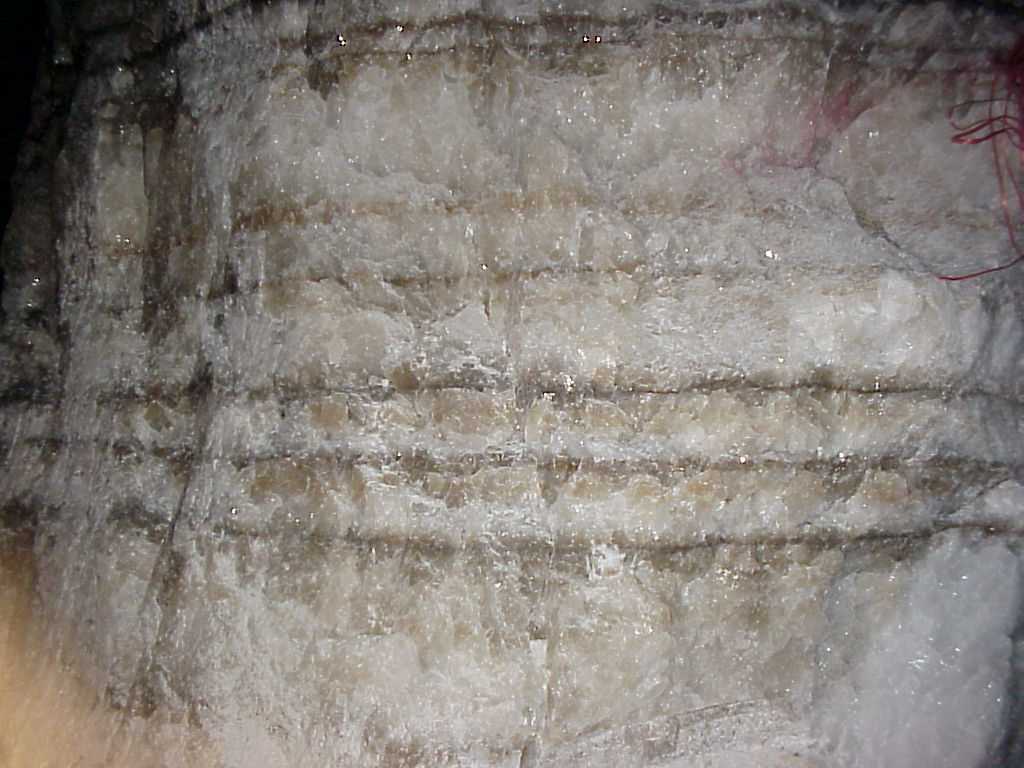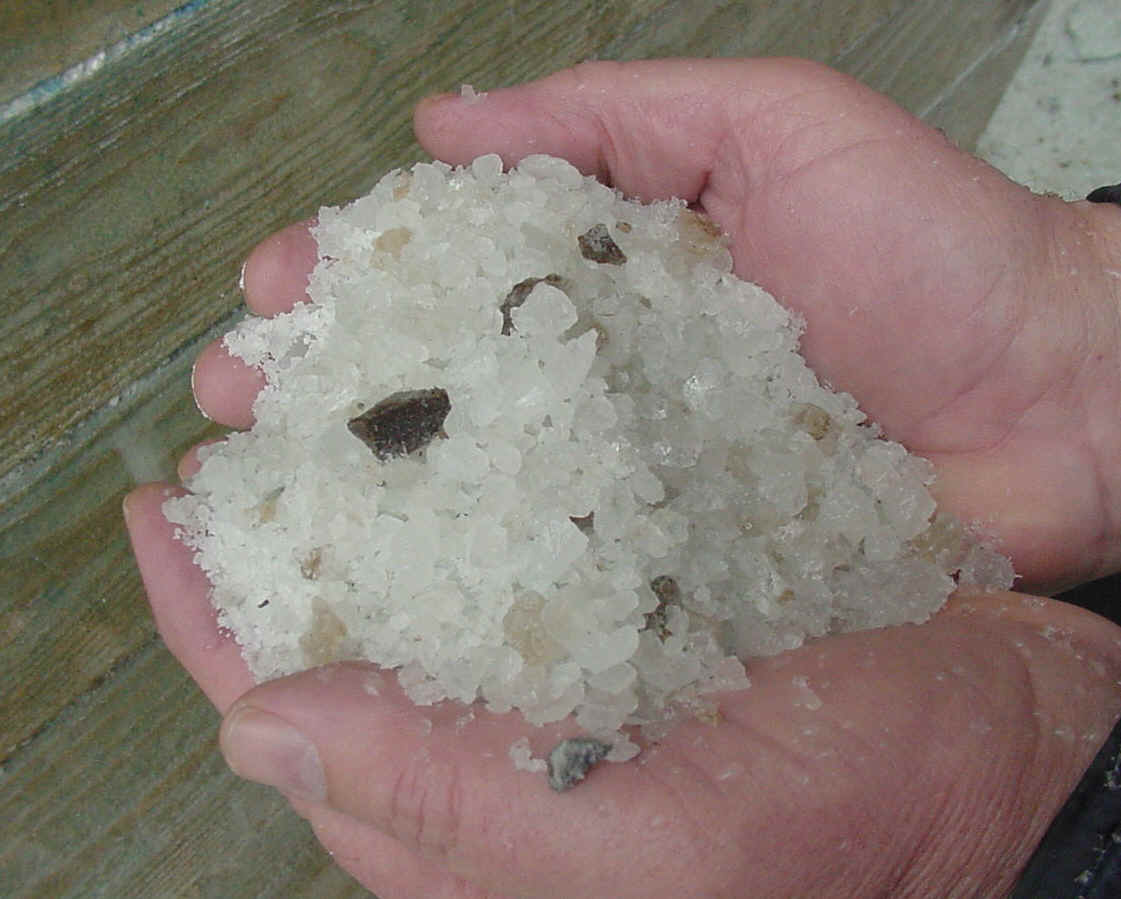

When you drive on an icy road, eat a potato chip or wear a pair of leather shoes, you
may be using one of Michigan’s least known natural resources - salt. During the
Paleozoic Era, beginning about 600 million years ago and ending about 230 million years
ago, seawater invaded the Michigan Basin at least six times. As the seas receded and
evaporated, rock and mineral deposits such as halite (rock salt), gypsum (calcium sulfate
with water), liquid brines, petroleum, lime, clay, sandstone and coal were left behind.

During the early decades of the 20th century, Michigan led the nation in salt
production. Michigan is a leading producer of many natural salines-underground waters
rich in chlorides, calcium, magnesium, sodium and, in lesser amounts, potassium, bromine
and iodine. Salt under Michigan has created fortunes, towns and manufacturing
centers.


The rock salt of the Michigan basin is one of the major sources of salt in North
America. The map below shows where "table salt" or NaCl, is found (pattern
of larger dots). Note that the salts are found within the center of the Michigan
Basin, which was surrounded by higher, reef deposits.
The image below shows salt beds exposed in a Michigan salt mine. The red markings are
spray paint, put on the walls to identify the location in the mine. From the top to
the base of the image is about a meter. Note that the salt occurs in distinct beds,
or layers. This layering is due to the fact that the salt was depoisted
layer-by-layer in an evaporation basin. The darker layers are still salt, but
contain some admixtures of silt and clay (i.e., the water was muddier then).

Halite salt (NaCl) can be
mined in two different ways: as a solution or in dry mining (see map below). In
solution mining, fresh water is injected through a pipe into deep shafts that end in the
salt beds, and salty water (brine) is drawn upward and dried, to recrystallize the
salt. Or, salty brine found in shallow wells can simply be pumped to the surface and
dried there, to make salt. In dry mining (below), the salt is mined in large underground
caverns, much like one would mine coal or iron ore. Dry mining is only practiced in
the Detroit area.

A radical change in salt production occurred in 1906 when the Detroit Salt and
Manufacturing Company started sinking a shaft for underground mining of rock salt. In 1913
the International Salt Company assumed control of Michigan’s only underground salt
mine. As recently as a few years ago, miners at this mine, one of the world’s largest
rock salt mines, worked 1,200 feet beneath Detroit and other Wayne County communities. The
mine, which consists of 100 miles of tunnels, has never experienced a collapse or mine
fatality. For years it produced tons of rock salt daily, most of which is used for ice
control. Today it is closed.

The room and pillar method of mining is employed in all salt mines in Michigan,
Ohio, and Ontario. The rooms vary in width from 30 to 60 ft and in height from
approximately 17 to 40 ft. Pillar size is adjusted so that the extraction or recovery will
attain a maximum of 70%. Actual mining is confined completely to the salt bed. Therefore,
usually a minimum of 1 ft of salt is left on the floor, while 4 to 6 feet of salt is left
to form the roof. Generally speaking, the absence of gas, water, excessive dust, and the
presence of sound roof and ribs as well as comfortable temperatures of 55° to 75° F,
permit working conditions in a salt mine to be excellent.
Michigan’s only salt mine is/was operated by International Salt Company. The
miners here have mined out an area 22 feet high for about 300 acres. Officials drive about
in automobiles on the solid salt underground "streets," which are 60 feet wide.
In the mine, the temperature is between 56 and 60 degrees in all season. The Company pumps
100,0000 cubic feet of fresh air a minute down one shaft. Unlike a coal mine, the
operation is free of the hazards of water and gas. The room-and-pillar system is used to
take out the salt. Rooms from 50 to 60 feet wide are driven out and blocks of salt of the
same width are left for roof support. Workmen "undercut" the walls of salt with
a machine that bites out a channel at the floor. Then holes are drilled in the wall from
floor to roof. At night, the holes are loaded with dynamite and the blasting operation
sends the wall of salt crumbling down. Electric shovels dip the salt into trailers the
next morning. Trucks powered by electricity take it to a giant crusher underground.
Reduced in size, the product is taken by conveyer to an underground screening plant where
the various sizes are separated. Again by conveyer, the salt is taken to the larger shaft
where it is lifted in nine-ton buckets.

The estimates of salt deposits in Michigan are astronomical. In the
Detroit area alone, it is believed that there are over 71 trillion tons of unmined salt.
Geological studies estimate that 55 counties of the Lower Peninsula cover 30,000 trillion
tons of salt.
1.Some of the images and text on this page were taken from various issues of Michigan History magazine and from C.M. Davis’ Readings in the Geography of Michigan (1964).